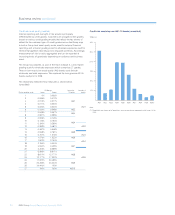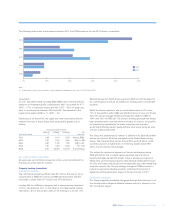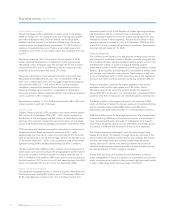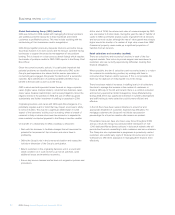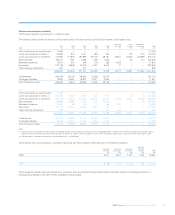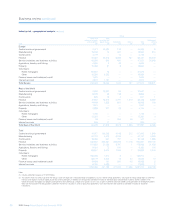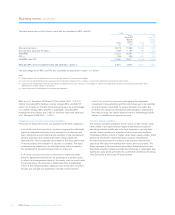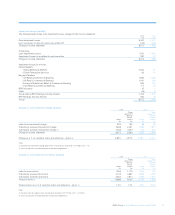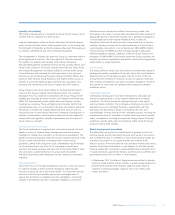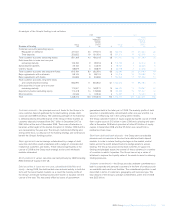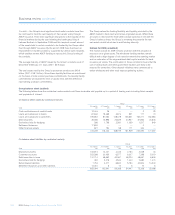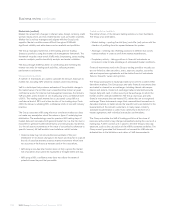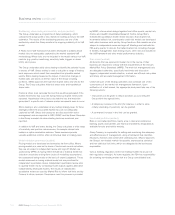RBS 2008 Annual Report Download - page 101
Download and view the complete annual report
Please find page 101 of the 2008 RBS annual report below. You can navigate through the pages in the report by either clicking on the pages listed below, or by using the keyword search tool below to find specific information within the annual report.
100
Business review continued
RBS Group Annual Report and Accounts 2008
The table below sets out the Group’s loans that are classified as REIL and PPL.
2008 2007
Group Group
before RFS before RFS
Holdings Holdings
minority minority
Group interest Group interest
£m £m £m £m
Non-accrual loans (1) 19,479 17,082 10,362 7,949
Accrual loans past due 90 days (2) 1,782 1,709 369 302
Total REIL 21,261 18,791 10,731 8,251
PPL (3) 226 226 671 131
Total REIL and PPL 21,487 19,017 11,402 8,382
REIL and PPL as % of customer loans and advances – gross (4) 2.52% 2.69% 1.64% 1.49%
The sub-categories of REIL and PPL are calculated as described in notes 1 to 4 below.
Notes:
(1) All loans against which an impairment provision is held are reported in the non-accrual category.
(2) Loans where an impairment event has taken place but no impairment recognised. This category is used for fully collateralised non-revolving credit facilities.
(3) Loans for which an impairment event has occurred but no impairment provision is necessary. This category is used for fully collateralised advances and revolving credit facilities where
identification as 90 days overdue is not feasible.
(4) Gross of provisions and excluding reverse repurchase agreements.
REIL as at 31 December 2008 was £21,261 million (2007 – £10,731
million). Excluding RFS Holdings minority interest, REIL was £18,791
million, an increase of £10,540 million during the year. As a percentage
of customer lending, REIL and PPL in aggregate, excluding RFS
Holdings minority interest was 2.69% of customer loans and advances
at 31 December 2008 (2007 – 1.49%).
Impairment loss provision methodology (audited)
Provisions for impairment losses are assessed under three categories:
•Individually assessed provisions: provisions required for individually
significant impaired assets which are assessed on a case by case
basis, taking into account the financial condition of the counterparty
and any guarantor and collateral held after being stressed for
downside risk. This incorporates an estimate of the discounted value
of any recoveries and realisation of security or collateral. The asset
continues to be assessed on an individual basis until it is repaid in
full, transferred to the performing portfolio or written-off.
•Collectively assessed provisions: provisions on impaired credits
below an agreed threshold which are assessed on a portfolio basis,
to reflect the homogeneous nature of the assets, such as credit cards
or personal loans. The provision is determined from a quantitative
review of the relevant portfolio, taking account of the level of arrears,
security and average loss experience over the recovery period.
•Latent loss provisions: provisions held against the estimated
impairment in the performing portfolio which have yet to be identified
as at the balance sheet date. To assess the latent loss within the
portfolios, the Group has developed methodologies to estimate the
time that an asset can remain impaired within a performing portfolio
before it is identified and reported as such.
Provision analysis (audited)
The Group’s consumer portfolios, which consist of high volume, small
value credits, have highly efficient largely automated processes for
identifying problem credits and very short timescales, typically three
months, before resolution or adoption of various recovery methods.
Corporate portfolios consist of higher value, lower volume credits, which
tend to be structured to meet individual customer requirements.
Provisions are assessed on a case by case basis by experienced
specialists with input from professional valuers and accountants. The
Group operates a clear provisions governance framework which sets
thresholds whereby suitable oversight and challenge is undertaken and
significant cases will be presented to a committee chaired by the Group
Chief Executive or the Group Finance Director.


